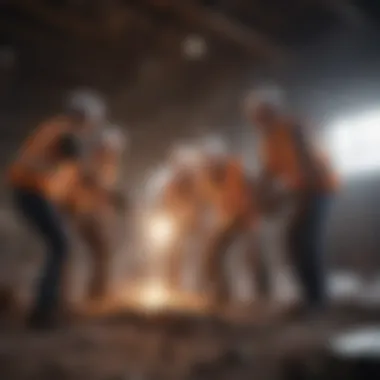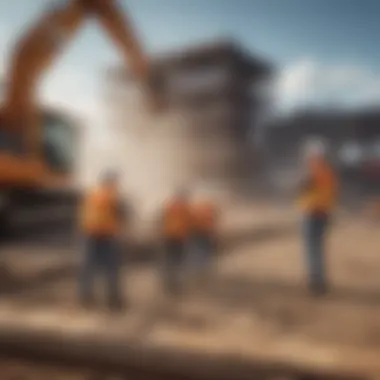Building Stronger Teams Through Construction Projects


Intro
When it comes to fostering a thriving work environment, constructing physical items as a team can provide more than just a sense of achievement. It opens doors to collaboration, innovation, and improved interpersonal dynamics within the workplace. Team building through construction projects allows members to step outside their usual roles, discover hidden talents, and learn to rely on each other's strengths. Not only does it enhance creativity but it also sharpens problem-solving abilities—essential skills in today's fast-paced business world.
This article serves as a roadmap for entrepreneurs and professionals seeking to harness the power of construction-based team activities. With practical insights and real-world examples, we will explore how such initiatives can transform teams into high-performing units. The following sections will unpack the various facets of these activities, shedding light on their relevance and benefits in promoting collaboration, engagement, and productivity.
Entrepreneurial Insights
When thinking about team building through creative projects, successful entrepreneurs offer a treasure trove of lessons. They have tapped into these activities not just for personal growth but to enhance team dynamics in ways that drive their businesses forward.
Entrepreneurial Success Stories
Consider a tech startup that engaged its team in building a small prototype of a product they were developing. Not only did this hands-on activity boost morale, but it also led to invaluable feedback as team members tested different concepts and ideas. Another great example is a non-profit organization, which brought together various departments to construct a community garden. This experience fostered team unity and allowed individuals to connect outside of their typical roles.
Challenges Faced by Entrepreneurs
However, not all construction projects run smoothly. Entrepreneurs often face obstacles such as lack of participant buy-in, time constraints, or unclear objectives. It is crucial to navigate these challenges head-on to ensure that the activities provide the intended benefits. Addressing concerns proactively and maintaining an open line of communication can help resolve issues as they arise.
Tips for Aspiring Entrepreneurs
For those embarking on similar ventures, here are some tips:
- Start Small: Choose projects that are manageable and encourage participation.
- Set Clear Goals: Have specific outcomes in mind before beginning a project.
- Encourage Involvement: Make sure everyone feels their contribution is valued.
"The best teamwork comes from men who are working independently toward one goal in unison." - James Cash Penney
These insights can lay the groundwork for a successful team-building experience.
Emphasizing Collaboration and Creativity
Diving deeper into construction projects, collaboration becomes the star of the show. Engaging team members in tangible tasks helps break down barriers and fosters a superior sense of camaraderie. This segment will discuss the various activities best suited for promoting collaborative efforts within teams.
Practical Construction-Based Activities
There are numerous activities that can be considered:
- Building Models: Teams can create physical models of products or concepts to visualize ideas better.
- Architectural Challenges: Using simple materials like cardboard, teams can design and construct structures based on certain criteria.
- Outdoor Projects: Engage in community-based construction projects, such as building park benches or playgrounds, to build relationships while contributing to the community.
Benefits of Engaging in Team Projects
Participating in these projects leads to several benefits:
- Enhances communication skills as team members exchange ideas and feedback.
- Encourages creative thinking, allowing individuals to brainstorm innovative solutions together.
- Instills a sense of ownership and pride in outcomes, positively impacting overall job satisfaction.
Ending
In sum, team building activities centered around construction projects present a plethora of advantages for businesses. By understanding the dynamics and opportunities of these initiatives, entrepreneurs can foster vibrant teams that not only achieve but excel in today’s competitive landscape. As we dissect the real-world implications of these activities, it becomes apparent that they are not just about building objects; they are about building stronger teams.
Understanding Team Building Activities
In a world where collaboration is key to achieving any goal, team building activities have become a cornerstone for organizations of all sizes. These activities not only increase productivity, but they also foster a sense of camaraderie among team members. When you look closely, the heart of these exercises lies in how they promote interaction and engagement, essential ingredients for any successful team.
Definition and Importance
To fully grasp the significance of team building activities, one must first understand what they entail. Team building activities refer to structured experiences designed to strengthen relationships among team members. This can range from casual social gatherings to more elaborate constructive projects that require collaboration and communication.
The importance of these activities can't be overstated. They serve as a platform for members to discover each other’s strengths, build trust, and cultivate an atmosphere where open communication thrives. When done correctly, they can enhance roles within a team and align individual goals with that of the group, ultimately leading to improved workplace morale.
Types of Team Building Activities
When it comes to team building activities, there are various types to consider, each carrying a unique flavor and focus.
Social Activities
Social activities offer a casual way for team members to connect outside of their typical work environment. Think of after-work barbecues or exciting escape room challenges. Their key characteristic is their relaxed nature, allowing individuals to drop their professional facades and engage in light-hearted banter. Not only does this familiarity make colleagues feel more comfortable, but it also helps break down barriers that might exist during work hours.
One unique feature of social activities is their ability to build trust through informal interactions. However, a potential downside can be the lack of structure, which might not resonate with all team members who prefer a more goal-driven experience.
Skill-Based Activities
Skill-based activities revolve around enhancing specific skills relevant to work, such as communication and problem-solving. These activities are designed not just to entertain, but to instill key competencies that could benefit the team in their day-to-day operations. A classic example is a workshop that engages team members in collaborative tasks requiring critical thinking, like a business simulation game.
The defining feature of skill-based activities is their focus on the development of practical skills in a fun setting. While they can be effective for goal alignment and personal growth, some might find such activities overly serious or not enjoyable enough, which can dampen enthusiasm.
Constructive Activities
Constructive activities are a slightly different ball game. They get to the very heart of teamwork by requiring members to build or create something tangible, such as a model bridge or a community garden. This hands-on approach not only requires cooperation, but ignites creativity and encourages innovative problem-solving among participants.
What sets constructive activities apart is the satisfaction of seeing a physical manifestation of teamwork in the end result, fostering a strong sense of achievement. However, they do come with the challenge of requiring more planning and resources than simpler social activities, which might make them logistically demanding.
In essence, understanding these various types of activities equips leaders with the tools to select the most appropriate method that aligns with their team’s goals. Each type has its own unique contribution to building a collaborative environment that drives success.
The Role of Building in Team Activities


Building activities serve as a vital mechanism in the realm of team development. They create a platform for individuals to come together, combining their distinct skills and experiences towards a common goal. This section of the article will explore two key facets of this role: the distinction between physical and conceptual building, along with the powerful dynamics that construction-related tasks introduce to teamwork.
Physical vs. Conceptual Building
When discussing building in a team context, we often split it into two categories: physical and conceptual.
Physical Building involves the tangible act of creating something with your hands, whether it's a bridge, a model, or even a garden structure. These activities can be hands-on and require actual materials. One immediate benefit of physical building is that it provides a clear, concrete objective around which team members can rally. Through activities like assembling a wooden structure, everyone has a role—cutting, measuring, or painting—which promotes teamwork and division of labor. It emphasizes collective effort, and as they see progress in their work, a sense of accomplishment boosts morale.
On the other hand, Conceptual Building focuses on developing ideas, frameworks, or strategies. In this case, 'building' refers to constructing plans or conceptual models that guide future actions. For instance, designing a marketing strategy or drafting a project outline can be seen as conceptual building. Here, teamwork often hinges on brainstorming sessions where creativity is paramount. Engaging in such activities cultivates flexibility within the team and highlights the importance of diverse perspectives.
Both forms play significant roles, but it's essential to consider how these activities align with the team's goals. Physical building might be better for teams that need to increase trust and communication in a short amount of time, while conceptual building may suit teams looking to innovate and strategize long-term.
Why Constructing Fosters Teamwork
Constructing something together allows team members to forge bonds that might be unachievable through traditional work dynamics. When individuals engage in building activities, they are often stripped of their usual roles, creating a level playing field where everyone can contribute uniquely.
- Shared Goals: At the heart of construction projects is a shared goal. Whether it be building a park bench or a model skyscraper, everyone works towards the same target. This common aim galvanizes team members and creates synergy as they progress together toward the final outcome.
- Enhanced Communication: Building necessitates a flow of ideas and discussion. Team members must communicate effectively to solve problems, plan logistics, and ensure that tasks are executed correctly. This open line of communication creates a culture of transparency, which is invaluable in a workplace setting.
- Problem Solving: Construction projects invariably throw curveballs—incorrect measurements, delays in materials, or unexpected design failures. Facing and overcoming these challenges as a unit sharpens a team's problem-solving skills.
"Working together in construction projects provides a live classroom for learning how to adapt and strategize as a group."
Through their involvement in direct, hands-on challenges, team members learn not just to lean on one another but to understand each other’s strengths and weaknesses. In the end, the act of assembling, whether it's bricks and mortar or ideas and plans, establishes strong foundations not only for structures but for cohesive teamwork.
The importance of building in team activities can't be overstated. It transforms team dynamics and boosts collaboration, and in a world where remote work becomes more common, these activities pave the way for trust and unity within teams.
Popular Team Building Constructive Activities
Engaging in constructive activities for team building is not just about pulling people together to work on a project; it’s about creating an environment that promotes collaboration and creativity. Activities like bridge building or Lego challenges evoke problem-solving, foster teamwork, and ultimately aim to strengthen the group. These activities serve a dual purpose: members not only learn to work together effectively but also get to produce tangible outcomes that they can be proud of. Therefore, the importance of such constructive sessions can’t be understated, especially in today’s fast-paced work culture.
Bridge Building Exercises
Material Selection
Material selection in bridge building exercises is crucial. Choosing the right materials can greatly influence the bridge’s structural integrity and the team’s ability to navigate challenges. For instance, if a team opts for lightweight materials, it might promote easier handling and creativity but could compromise durability. On the flip side, selecting heavier materials might bring about challenges in logistics but allows for more robust constructions. This balance—it plays a key role. Consider this: teams that collaborate on material selection often share insights, which fosters a deeper understanding of each person's perspective.
Design Challenges
Design challenges push teams to innovate. The initial architectural choices can spark discussions about functionality, aesthetics, and even environmental impact. Most importantly, these challenges tap into a team's collective knowledge, driving members to think critically about their design. Often, the back-and-forth discussion leads to discovering unexpected solutions. This kind of problem-solving not only hones design skills but also builds trust within the group. When a design fails, it becomes a learning moment, demonstrating that failure can fuel improvement instead of hindering progress.
Testing Durability
Testing durability is a key stage. Evaluating how a bridge holds up under pressure not only offers practical benefits but creates a sense of accountability among team members. It’s one thing to build; it’s quite another to test and witness the results firsthand. Durability testing challenges the team to think critically about their designs, prompting them to consider potential weaknesses. This iterative process can reveal insights into each member’s thought patterns and strengths, laying a foundation for future collaborative efforts. Seeing their project withstand challenges can lead to a boost in morale and cohesion among team members.
Lego Building Challenges
Creative Thinking
Creative thinking is at the heart of Lego building challenges. It encourages team members to set aside conventional boundaries, paving the way for innovation. When given a mix of Lego pieces and a challenge, the range of possible outcomes is limited only by the group’s imagination. Engaging in this type of activity fosters an openness to ideas and brings forth various perspectives on how to achieve a common goal. This fluidity can spark conversations that elevate teamwork, as individuals bounce ideas off one another like a game of mental volleyball.
Time Constraints
Time constraints in Lego challenges can seem daunting but they serve as a catalyst for focused efforts. When the clock is ticking, teams quickly learn the value of prioritizing tasks and collaborating efficiently. This urgency often leads to creative compromises that can push the envelope of what a team initially envisioned. However, while time pressures can create a stimulating environment, it’s essential to manage stress levels to not let the anxiety overshadow the creativity. Striking a balance between pressure and creativity can yield impressive—and sometimes unexpected—results.
Group Coordination
Group coordination becomes crucial during Lego challenges. As members rush to assemble their ideas, efficient communication becomes essential. A leader often emerges as someone who is adept at guiding discussions, ensuring that everyone feels heard. Balancing tasks like building, discussing, or problem-solving requires that each member fully understands their role. This kind of structured coordination not only minimizes confusion but also empowers individuals to take ownership of their contributions. Ultimately, it instills a collective sense of accomplishment when the final masterpiece is revealed.
Outdoor Construction Projects
Garden Projects
Garden projects serve multiple purposes—they are practical and nurturing. They allow teams to connect not just with each other, but also with nature. Getting hands dirty while planting flowers or vegetables fosters a shared sense of responsibility. This type of physical work can reinforce bonds among team members while also providing tangible results, as they watch their efforts come to fruition over time. One of the unique features of garden projects is their low barrier to entry; anyone willing to dig in can contribute, making it an inclusive activity that encourages participation from all.
Park Equipment Installation
Park equipment installation introduces an element of community service, creating a deeper sense of purpose among team members. Collaborating on such projects enhances their public skills as they work not only with each other but also interact with other community members during the process. Here, teams face unique obstacles: ensuring proper safety measures, understanding community needs, and coordinating logistics with local authorities. Despite the challenges, successfully installing new equipment often leads to a rewarding shared experience for the entire team. This sense of giving back can promote camaraderie that extends far beyond the construction itself.
Community Service Builds
Community service builds blend social responsibility with constructive collaboration. By engaging in projects like building homes or refurbishing schools, teams experience the impact tangible contributions can have on a community. These activities cater to a mixture of challenges, including project management, logistics, and communication with stakeholders. One of the remarkable aspects of engaging in community service is the emotional satisfaction that emerges when teams witness their contributions positively affect others. Such projects are fertile ground for discussions about interpersonal dynamics and team values, reinforcing the bonds that formed during the endeavor.
Investing efforts in constructive activities can profoundly realign the values and operations of any team, translating collaborative efforts into improved workplace dynamics.
Facilitating Effective Team Building Activities
Facilitating effective team building activities is a crucial pillar in enhancing collaboration within teams, especially when these activities include construction projects. It goes beyond mere interaction; it’s about creating an environment where every member feels valued and can contribute. By ensuring that activities are not only engaging but also suitable for the dynamics of the group, organizations can unlock untapped potential within their teams. The right facilitation can turn a simple building project into a transformative experience, allowing participants to foster relationships, hone skills, and improve their problem-solving abilities.
Selecting the Right Activity
Choosing the right activity is fundamental in facilitating effective team building. It requires a fine balance of understanding the team’s dynamics, objectives, and available resources.
Understanding Team Dynamics
Understanding team dynamics involves assessing how individual personalities and roles mesh within a group. This aspect is essential because no two teams are the same; each comes with its own nuances. Recognizing these dynamics can greatly enhance the effectiveness of the activity. One key characteristic of this understanding is its focus on the interrelationships among team members. When activities are tailored to fit these dynamics, it creates harmony and maximizes involvement. Teams that align activities with their unique dynamics tend to experience better engagement.


The unique feature of understanding team dynamics is that it helps identify strengths and weaknesses within the group. A common advantage of this approach is that it can uncover hidden talents or areas requiring development. However, a disadvantage might be the time required for thorough assessment, which could postpone the activity itself.
Identifying Objectives
The process of identifying objectives ensures that the team knows what they want to achieve through the activity. This clear goal-setting is beneficial as it provides direction. One important characteristic here is the specificity of the objectives, which aligns the activity with the team’s mission. A well-defined objective helps participants understand the purpose, thereby increasing motivation and focus during the project.
Uniquely, identifying objectives can highlight which skills to develop through the activity, whether it’s communication, leadership, or collaboration. This contributes to creating a tailored experience that addresses the needs of the team. However, too many objectives can lead to confusion and dilute focus, thus making it counterproductive.
Assessing Resources
Before diving into team building activities, it is crucial to assess the resources available. This includes everything from budget to materials and time. The significance of assessing resources lies in its role in practicality; ensuring that the selected activities are feasible based on the organization’s constraints. A primary characteristic is the evaluation of physical and financial resources available, which ultimately supports a well-structured plan.
The unique feature here is that resource assessment encourages creativity in problem-solving. Teams may find innovative ways to make the most out of limited resources, which can also foster a sense of accomplishment. On the flip side, if there are significant limitations on resources, it might restrict the scope of activities that can be pursued, which could impact the overall team experience negatively.
Creating a Collaborative Environment
A collaborative environment is one where everyone feels comfortable contributing and working together towards a common goal. This encourages not only participation but also innovation.
Setting Ground Rules
Setting ground rules establishes clear expectations for conduct during the activities. This aspect enhances accountability and fosters respect among team members. A key characteristic of this practice is that it promotes fairness, ensuring that everyone knows their rights and responsibilities during collaboration. Establishing these rules is often a beneficial practice as it creates a safe space for engagement.
The unique advantage of ground rules lies in their potential to prevent conflicts before they arise. However, there can be challenges if the rules are too rigid, possibly stifling creativity and spontaneity among team members.
Encouraging Open Communication
Encouraging open communication plays a vital part in enriching team building activities. Transparency in sharing thoughts and feedback allows for more collaborative problem-solving. A main characteristic is fostering an environment of trust, where team members feel they can express themselves without fear of judgment. This is hugely beneficial as it enhances relationships and encourages a flow of ideas.
The unique feature is that when communication is open, it can lead to unexpected innovations and solutions, as diverse perspectives are welcomed. Yet, too much openness might lead to a lack of focus, where discussions drift away from the task at hand.
Promoting Inclusivity
Promoting inclusivity is essential in creating a diverse and harmonious team environment. All voices should be heard and valued, which enhances team morale and creativity. A key characteristic is recognizing and respecting differences among team members, which can enrich problem-solving. Inclusivity is a beneficial approach that not only improves team dynamics but also fosters innovative thinking, as each member brings unique perspectives.
A distinct feature of promoting inclusivity is that it can lead to a stronger sense of belonging among team members, fostering loyalty and commitment. However, if not handled carefully, inclusivity efforts may inadvertently focus on too much diversity at the expense of cohesiveness.
Debriefing and Reflection
Debriefing and reflection is a critical step post-activity that enables teams to assess their experiences and extract value from the activities they just completed.
Gathering Feedback
Collecting feedback involves soliciting insights from participants about their experiences during the activity. This is fundamental as it gauges the effectiveness of the team-building exercise. A key characteristic of feedback gathering is the focus on both positive and constructive comments, which helps spark discussions. It proves to be beneficial, as understanding participants’ perceptions can provide crucial insights for future activities.
The unique aspect here is that feedback can also bring hidden concerns to the surface, leading to necessary adjustments in future planning. On the downside, some individuals may hesitate to provide honest feedback, especially in large group settings.
Identifying Key Learnings
Identifying key learnings is vital for translating experiences into actionable insights. Capturing what worked well and what could be improved is at the heart of continuous learning. A key characteristic is the emphasis on highlight moments of success and areas for growth. This process is beneficial, offering clarity on the cultural and operational changes needed.
The unique feature is that these learnings can drive future team-building strategies and activities. However, a challenge can arise if teams focus too heavily on failures rather than celebrating successes, which can negatively affect morale.
Planning for Future Improvements
Planning for future improvements takes the reflections and learnings from debriefing and turns them into actionable strategies for enhancement. This step involves prioritizing changes based on the feedback received. A characteristic is that it encourages forward-thinking and a growth mindset, making it a beneficial multiplier for team development.
The unique feature of planning for improvements is that it creates a continuous loop of learning and growth. Nonetheless, failure to implement these plans adequately might lead to disappointment and skepticism about future team-building initiatives.
Evaluating Outcomes of Team Building Activities
Evaluating the outcomes of team building activities is crucial for understanding how effective these initiatives are in fostering collaboration and enhancing team performance. It allows organizations to assess whether their construction projects have truly achieved their intended goals. The evaluations can illuminate areas of strength and weakness, offering insights that can shape future endeavors. Without such assessments, teams may find themselves repeating the same mistakes or, at the very least, not realizing their full potential.
In this section, we will break down the methods for evaluating outcomes, emphasizing important elements such as measuring effectiveness and identifying long-term benefits. This approach doesn't just provide a snapshot of performance; it allows for reflection and the continuous improvement of team dynamics, ultimately contributing to organizational success.
Measuring Effectiveness
Surveys and Questionnaires
Surveys and questionnaires are one of the most direct methods for gauging the impact of team building activities. They can gather feedback from participants regarding their experiences, perceptions, and overall satisfaction. A significant characteristic of this method is its ability to provide quantitative data that can be easily analyzed.
What makes surveys appealing is their ease of distribution and completion, catering to teams that may be busy and pressed for time. However, a unique challenge lies in ensuring that the questions are designed to extract deep insights rather than surface-level responses. Despite this, the feedback can be invaluable in highlighting both what worked and what did not in the activity.
Performance Metrics
Performance metrics introduce a more numerical approach to evaluating team building activities. These metrics can range from productivity levels post-activity to specific KPIs aligned with project goals. The key characteristic of performance metrics is their objectivity, offering hard data that can pinpoint improvements or dips in team effectiveness.
However, the unique feature of performance metrics can sometimes be their narrow focus on quantifiable results, which may not fully encompass the qualitative benefits of team building. Therefore, while they are beneficial in guiding decisions, relying solely on numbers can miss the underlying interpersonal dynamics that give rise to successful collaborations.
Behavioral Observations
Behavioral observations involve monitoring and assessing team interactions during and after the activities. This approach allows facilitators to see firsthand how team members relate to each other, which is critical for understanding communication patterns and teamwork dynamics. A key characteristic of behavioral observation is its qualitative nature—offering insights that surveys and metrics may overlook.
The unique advantage of this method lies in its ability to identify subtle shifts in group behavior and morale. However, it does carry the challenge of potential biases from the observer's perspective, which can skew the interpretations of the interactions. Thus, combining this method with others can yield a more rounded view of the outcomes.


Long-Term Benefits
Enhanced Collaboration
One of the major long-term benefits of team building through construction activities is enhanced collaboration among team members. Enhanced collaboration speaks to the improved interpersonal skills that teams develop over time. The memorable nature of construction projects fosters shared experiences that translate into smoother interactions at work.
This characteristic makes the building activities a popular choice; they engage individuals in hands-on tasks that require teamwork and problem-solving. The unique feature is that the bonds formed during these activities can significantly positively affect daily work communication and efficiency. However, organizations must remember that continuous effort is necessary to maintain these positive relationships.
Improved Innovation
Improved innovation is another potential long-term benefit that stems from engaging in constructive team activities. Encouraging teams to think outside the box while constructing something tangible can spark newfound creativity. The dynamic environment offers a break from routine, prompting fresh ideas to emerge.
The key characteristic of this benefit is that it is not just about creating a new product or solution but fostering a mindset of innovation within the team. A distinctive aspect of improved innovation is its potential impact on the organization's overall adaptability in a rapidly changing market. However, teams must cultivate an atmosphere conducive to experimenting with ideas to fully realize this benefit.
Increased Morale
Lastly, increased morale is a significant long-term advantage of team building construction projects. Engaging in creative, hands-on activities can invigorate team spirits, making members feel more valued and involved in the organization's goals. This elevated morale can lead to decreased turnover and greater job satisfaction.
The characteristic of increased morale makes it an appealing result for any organization aiming for higher employee retention. The unique feature is that, when morale improves, it can subsequently boost productivity and collaboration. However, maintaining this boost requires ongoing efforts, as teams may face challenges if the excitement of the initial activities wanes.
Evaluating the outcomes of team building activities is not just a retrospective analysis; it's a forward-looking framework that can reshape a team's trajectory, ensuring that every brick laid in construction builds towards a stronger foundation.
Challenges in Team Building Construction Activities
In any team building initiative that revolves around construction activities, challenges are par for the course. Identifying these hurdles is crucial not only for preventing potential breakdowns in collaboration but also for actively reaffirming team cohesion. The dynamics of building things together can uncover underlying issues which, if not addressed, might overshadow the positive impacts of the activity itself. Therefore, being aware of common challenges like conflicts among team members and resource limitations becomes essential in shaping effective team building experiences.
Potential Conflicts
Role Confusion
Role confusion arises when team members are unsure of their responsibilities in a construction project. This dilemma can lead to overlapping tasks or critical activities being overlooked entirely. In a high-stakes environment, where clarity is king, role confusion may hinder productivity and create frustration within the group. It’s particularly detrimental in building activities where precise roles affect the outcome. By establishing specific duties ahead of time, teams can better navigate these muddy waters. This proactive measure not only helps delineate responsibilities clearly but also capitalizes on each member’s strengths, ensuring that everyone contributes effectively.
Personality Clashes
Working together often brings different personalities into contact. Personality clashes can quickly become a sticky wicket, leading to tension and disrupted workflow. Such conflicts typically stem from differing values, work ethics, or simply misaligned communication styles. Recognizing these clashes can be a golden opportunity for growth. When teams address personality differences openly, they can cultivate an environment where diverse perspectives are appreciated instead of rejected. This way, personality clashes, albeit inconvenient, can foster deeper understanding and cooperation, thus enhancing overall team dynamics in construction projects.
Communication Barriers
Communication barriers present another significant challenge in team building construction activities. Misunderstandings can arise from unclear instructions or a lack of feedback, causing confusion and, at times, chaos during the building process. This is particularly true in diverse teams, where language nuances can become an obstacle. Encouraging open lines of communication and setting the expectation for feedback can mitigate these challenges. Ironing out potential communication wrinkles can lead to smoother collaboration and a more effective construction process. Moreover, fostering an open culture around resolving communication issues often pays off when it comes to team efficiency and morale.
Resource Limitations
Budget Constraints
When financial limitations come into play, they can severely restrict a team's ability to successfully complete construction projects. Budget constraints force teams to get creative, often resulting in innovative solutions. In fact, these limitations can prompt critical thinking and collaboration as teams must find effective ways to maximize available resources. Developing a budget that aligns directly with project goals ensures that teams keep their eyes on the prize, steering clear of frivolous expenditures while maintaining focus on what's essential.
Material Accessibility
Material accessibility poses another level of challenge, impacting not just the timeline but also the quality of the finished product. Sometimes, the materials needed for a project aren't readily available, necessitating alterations to design or function. However, encountering material shortages can lead to unanticipated creative opportunities. Teams might experiment with alternative materials or methods, resulting in outcomes that can surprise everyone involved. Therefore, while material accessibility is a practical concern, it can also be a driving force for innovation.
Time Restrictions
Finally, time restrictions can create an atmosphere of pressure that might stifle creativity or lead to rushed work. When deadlines loom, the urge to cut corners can be strong. On the flip side, time limitations also teach teams to prioritize effectively, honing their ability to navigate tasks efficiently. Establishing clear time frames for each stage of the project can help maintain focus, helping the team strike a balance between speed and quality. Learning to work under pressure is an invaluable skill that can translate into future team endeavors, allowing teams to handle deadlines with increased poise.
The challenges faced during team building activities serve as stepping stones rather than roadblocks. Addressing these elements can not only enhance team cohesion but also lead to innovative problem-solving strategies.
In summary, navigating the complexities of construction-related team building can yield substantial growth opportunities when teams tackle potential conflicts and resource limitations head-on. Understanding the inevitable challenges can inform future activities and empower teams to transform difficulties into learning opportunities.
Case Studies of Successful Team Building Through Construction
The concept of using construction projects for team building is not just a trend; it is a multifaceted approach that has proven effective across various sectors. Case studies serve as powerful narratives that showcase the impacts and lessons learned from these activities. They not only illustrate how construct activities enhance teamwork but also provide tangible evidence of their benefits. Each story can highlight how different environments, such as corporate settings or community-focused efforts, can uniquely shape the dynamics of team building.
Corporate Examples
Tech Industry Initiatives
Tech companies often rely on collaborative tools and platforms, but nothing beats the hands-on experience of creating something tangible. For instance, Google's internal team-building days often include construction projects like building bridges or ramps. These initiatives promote not just project management skills but also critical problem-solving abilities. A core characteristic of these tech initiatives is their emphasis on innovation through construction. Teams get a chance to physically build prototypes, fostering a sense of ownership and boosting creativity.
One notable unique feature is that these projects are frequently tied directly to ongoing tech solutions, meaning they contribute to real-world applications. One advantage is the way these projects parallel the agile development processes used in software development. However, the downside can include participants feeling inequalified initially since construction skills may not be part of their regular job duties.
Non-Profit Projects
Non-profit organizations often employ construction activities to build community spaces or refurbish local facilities. A specific example is Habitat for Humanity, where volunteers, including corporate teams, come together to build homes for those in need. The transformative aspect of these projects not only provides physical shelter but also fortifies team bonds as employees work towards a shared purpose. This characteristic of altruism makes non-profit projects particularly rewarding and motivating for team members.
These initiatives uniquely blend building skills with social responsibility. One advantage is the positive public relations impact they can have on the organizations involved, boosting their reputation as socially responsible entities. However, these types of projects can often demand emotional investment and engagement, which might lead some participants to feel overwhelmed if they can't fully commit.
Start-up Team Experiments
Start-ups often operate in fast-paced environments where adaptability is key. Many emerging companies utilize construction projects as a means to cultivate an agile workforce. For example, companies like WeWork have hosted pop-up building events where team members collaborate to design and execute unique office spaces. A striking characteristic of these experiments is their flexibility; teams can pivot quickly and innovate on-the-spot, enhancing their problem-solving skills in real-time.
The unique feature of these start-up initiatives is the low-pressure environment they create, allowing for creativity to flow freely. This can lead to some of the most original ideas that later turn into company products or strategies. The downside might be that the lack of structure can sometimes result in disorganization, which may deter some team members who prefer clear guidelines.
Key Takeaways
Through these various case studies, a few vital points emerge regarding team building through construction projects:
- Team Dynamics: Engaging in these activities can lead to better interpersonal relationships, enhancing overall team cohesion.
- Skill Development: Participants often learn new skills that are transferable to their work settings, increasing versatility.
- Shared Accomplishment: The sense of achievement derived from completing a project together fosters pride and unity among team members.
In summary, case studies of successful team building through construction highlight diverse practices across industries. They show how tangible projects can lead to stronger teamwork, encourage innovative thinking, and create impactful community contributions.







